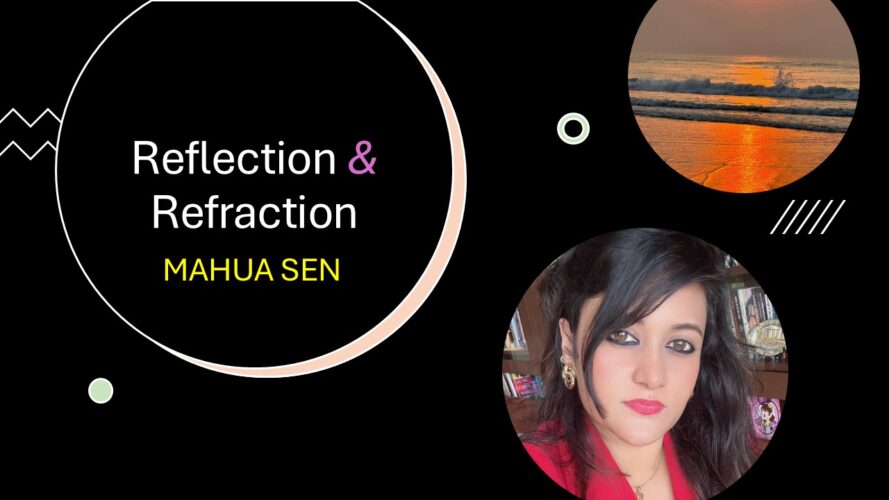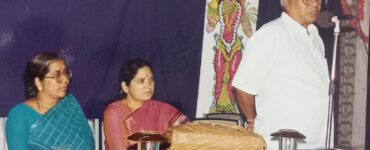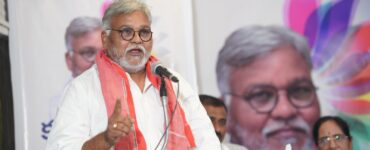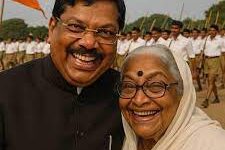Lakshmi Murdeshwar Puri’s debut novel Swallowing the Sun (Aleph) is a unique genre-defying work that integrates history, politics, poetry, theatre, and romance into a sweeping narrative. But above all, it is a feminist novel at its core; an ode to resilience, voice, and an abiding courage of women and men to shape both private and public worlds.
Puri, a former Assistant Secretary-General at the United Nations and Deputy Executive Director of UN Women, brings to the page the depth and wisdom of her 43-year career in diplomacy and development. Her lived experience gives the novel a veracity and intellectual grandeur that is rare in fiction. It is rightly called the most powerful novel of the 21st century by a debut author. This is a writer who has not only stood up to live; as Henry David Thoreau once said is vital before one dare to write, but has broken barriers and created, implemented and transformed institutions along the way for amelioration of the human condition.
The novel’s epigraph, drawn from a devotional abhang by the 13th-century mystic poet Muktabai, is more than a poetic begining; it is the soul of the book. Muktabai’s voice, echoing and reverberating across centuries, becomes a spiritual and philosophical thread that flows through the narrative like a fjord, inspiring its title and guiding and shaping its thematic tang.
“The ant flies into the sky,
She swallows the sun.
Another miracle!
The barren woman begets a son.
A scorpion burrows down to the nether realms,
And Sesha, the snake king, bows its head at its feet.
A fly gives birth to a hawk.
Muktabai sees all.
Muktabai laughs.”
These verses unfurl an entire universe where the impossible translates into possible, where miracles exhale through metaphors, and where the flight toward the zenith on the metaphorical wings, carry the rage of fire. The unrelenting aspiration to chase the sun, even knowing it may consume you, is the soul of this novel.
This is a journey of experience more than destination; a pilgrimage through hope, resilience, defiance, patience, and will. It is in the scars, the lakshmanrekhas crossed, and the silences broken that the truth of becoming is born. Through the lives of Malati, Kamala, Sarala, Surekha, Guru, and others, we witness a chorus of transformations—fragmented identities reconstructing into voices of power, courage blooming from chaos, and moments of stillness echoing with conviction for the unachievable.
Like colourful threads in a hand-woven embroidery, their stories are geometrically different in shape and colour, yet, the commonality is, they are tender, and true. Each one pulses with a yearning; to belong, to transcend, to matter, to bring about a change.
As Matthew McConaughey writes in Greenlights:
“I haven’t made all A’s in the art of living. But I give a damn.
And I’ll take an experienced Cover an ignorant A any day.”
This book breathes that same truth.
Anchored in the nostalgia of 148 handwritten letters from the author’s father to her mother, the story blooms from the casket of memory and love. It is, evidently, a labor of the heart; tender yet intense, rooted yet soaring.
The dominant theme of the novel circles around the protagonist Malati’s relentless struggle and resilience as she strives with fierce conviction, to achieve what seems impossible. Inspired by the author’s mother, Malati’s journey reflects her dynamic relationship with Guru (based on the author’s father), set against the backdrop of one of the most tumultous socio-political periods in Indian history. The narrative explores the conflicts and alliances among its characters and showcases Malati’s unwavering “can-do” spirit, whether it’s wrestling an older male classmate, confronting dacoits, engaging in intellectual discourses and debates, interacting with revolutionaries in Banaras, or resuming her law studies to defend those very revolutionaries in court.
Malati refuses to fade into the background like an anonymous shadow wafting through the conurbations. Instead, she boldly challenges societal narratives, much like Muktabai’s ant that dares to fly into the sky to swallow the sun, crossing many ‘Lakshmanrekhas’ drawn for women. Throughout the novel, she offers profound reflections on faith, resilience, and courage, emphasizing how seemingly small, everyday choices can shape one’s destiny which also impacts the lives of others around them. Her journey takes her through various life promenades, from the orphanage to Elphinstone College, BHU, and beyond.
The tale also highlights the remarkable spirit of the youth of that era, who, despite the odds, were driven to join the freedom movement, at a time when defeating the British seemed nearly impossible. It’s a narrative of civilizational and cultural awakening, self-discovery, and inspiration. A compelling feature of the novel is how its characters cross paths with historical figures such as Annie Besant, Madan Mohan Malviya, Mahatma Gandhi, Savarker, Mama Varerkar – the renowned Marathi playwright of the time, and many others.
The author demonstrates her talent by gifting her readers a compelling and emotionally rich reading experience through conflicting scenes presented with vivid freshness. She effortlessly allows us to glimpse the blend of personal, moral, and social issues, all set against the backdrop of progress and modernity knocking on the doors of a deeply traditional society. Yet, the narrative never feels didactic; instead, it evokes a deep sense of empathy, even at times, with the antagonist; Maa Saheb, which I found to be extremely intriguing.
Although the story is inspired by Puri’s parents’ exchange of letters and real-life incidents, it remains a work of fiction. Fictional characters and events shape the filigree of the narrative arc. When I asked the author why she chose fiction, she told me, “I wanted to play God.” Fiction, she believes, allows the writer to create. In that sense, the author becomes the sutradhaar; the master puppeteer — holding the symbolic string that moves and controls the characters and their worlds. As Albert Camus once said, “Fiction is the lie through which we tell the truth.” Indeed, every work of art contains elements of truth and the lived experiences of its creator.
The story begins with Malati and her sister Kamala attending the village school as the only girls in their class. They later become pioneers, attending Elphinstone College and excelling in higher studies, at a time when women’s aspirations were reduced to the blur of forgotten names. The story also sheds light on the cultural oppression women endured. Malati’s elder sister Surekha is married off to a man nearly her father’s age. Neither Sarala nor Veena can assert their choices in life. Kamala undergoes the isolating and dehumanizing rituals of puberty; confined to a dark room, her meals left outside the door during menstruation. This immediately brought to mind the words of 14th-century Dalit mystic poet Soyarabai, mentioned by author Arundhathi Subramaniam: “If menstrual blood is impure, tell me who wasn’t born of that blood?” This powerful line provokes critical reflection.
At its core, the story highlights that even a hundred years ago, some women transcended the boundaries imposed by patriarchal narratives. These women were true rebels, breaking every stereotype of the submissive Indian woman. At one point, Malati declares, “If women are the prakriti incarnate, then why are they treated as the 5th caste, and men rule?”The story challenges such orthodox, misogynistic ideologies. There’s even a reference to Maharshi Karve’s message to fathers: “Real kanyadaan is when you dedicate your daughter to Ma Saraswati, the Goddess of knowledge,” underscoring the importance of education.
One of the story’s fascinating aspects is how these pioneering women had the support of the men in their lives. We often hear that “behind every successful man is a woman,” but Swallowing the Sun reminds us: “behind every successful woman, there is a man.” Whether it is Baba inspiring his daughters Kamala and Malati to pursue education, Malak encouraging his sisters-in-law, or Guru serving as Malati’s unwavering pillar of support — these male allies play crucial roles. The relationship between Malati and Guru, in particular, is deeply compelling. Their conversations offer layered perspectives, and Guru’s reverence for Malati — calling her “the Goddess in my sanctum sanctorum”, adds emotional and philosophical depth reminding us of the sloka from Manusmriti “Yatra naryastu pujyante, ramante tatra devata”, meaning, where women are revered, divinity resides.
However, not all male characters remain consistent. Baba, while supportive of Kamala and Malati’s education, marries off his eldest daughter Surekha at age 15 to Malak, a man his own age. Malak, who initially appears progressive, later becomes aggressive and patriarchal, subjugating his wife and daughters. He denies his daughter Sarala the chance to attend college, forcing her into marriage. He even sends his daughter Veena back to a toxic marriage. These contradictions in male characters raise important questions about hypocrisy and internalized patriarchy.
Ultimately, the book is about relationships; how people influence and transform one another, how the social milieu shapes the individual, and the power and the lack of personal choice.
Another unique and remarkable aspect of the book is its use of poetry and literary references across languages, many of them translated. These references offer a layered expression to the narrative; from Kafka’s Metamorphosis to Shakespeare’s Julius Caesar, from Dickens’s A Tale of Two Cities (“heap of ashes that I am”), to Maugham’s Of Human Bondage (“we are not the same person this year as last”), from A Room with a View by E.M. Forster to classical Indian texts like Meghaduta and Abhijnanasakuntalam and Greek mythology.. There are also beautiful incorporations of Sant Tukaram’s poetry and others. These intertextual elements are seamlessly woven into the narrative and enrich its visual and emotional language. Double entendres and wordplay enhance the creative expression, as the story oscillates between utopian and dystopian tones, reflecting the dichotomy of the world we live in.
The book is replete with twists, turns, and revelations. The storytelling is evocative, almost visual in its impact, as if it seeks a dialogue with the reader’s inner world, constantly raising questions. The author’s narrative style is deeply empathetic, making the characters feel real and relatable. Emotionally, it has left a lasting impression on me, a book I will never forget. The writing is vivid, descriptive, and emotionally stirring, wrapped in a gripping plot with dynamic characters. The author is exceptionally talented, and I eagerly look forward to reading more of her work.
*









Add comment